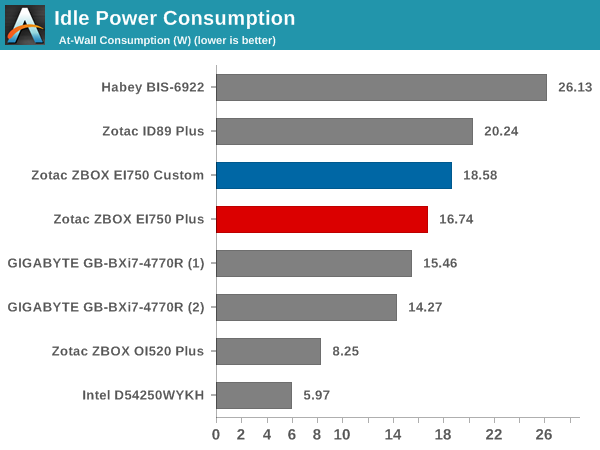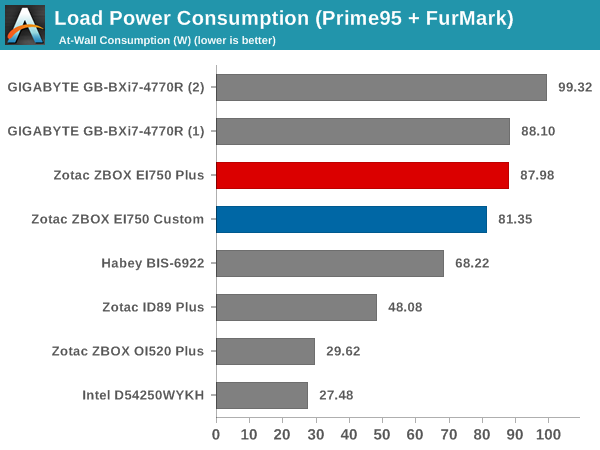Zotac ZBOX EI750 Plus: A Feature-Rich Iris Pro mini-PC
by Ganesh T S on August 25, 2014 7:00 AM ESTMiscellaneous Aspects & Final Words
The power consumption at the wall was measured with the display being driven through the DVI-HDMI port. In the graphs below, we compare the idle and load power of the ZBOX EI750 Plus with other low power PCs evaluated before. For load power consumption, we ran Furmark 1.12.0 and Prime95 v27.9 together. The addition of a SODIMM and an extra mSATA SSD in our custom configuration obviously drives up the idle power consumption numbers a bit, a penalty the user needs to pay for better performance. However, the load power consumption numbers show an inversion because the extra RAM causes heavier throttling, bringing down the load power numbers in steady state below that of the Plus configuration.


Thermal Performance
Given the active nature of the thermal solution and the size of the chassis, it would have been fair to expect the unit to be able to handle full loading of the CPU and GPU without issues. Unfortunately, just like the BRIX Pro, the unit throttles under heavy artificial loading (Prime 95 + Furmark). Unlike the BRIX Pro, the unit even throttles under pure CPU loading. The gallery below presents the different cases.
Only the pure GPU loading case doesn't throttle. This is definitely a bit disappointing, but, only from a purely engineering standpoint. The usual use-cases rarely stress the CPU and GPU to these limits. Intel is also heavily promoting the scenario design power metric for thermal design. The CPU and GPU don't do as much work as in our power virus test.
Concluding Remarks
I have been using the unit as a virtualization platform, running a Windows 7 VM and a CentOS 6.2 VM simultaneously, each of them with a dedicated wired network link. The in-built Wi-Fi is used for the host OS. The ability to put in up to 16 GB of RAM and back up the mSATA SSD with the already supplied 1 TB 2.5" HDD provides more than enough storage. With the VMs inactive, I have been using this as a compact and silent low-power software development machine with higher performance compared to other Zotac ZBOX units. Unfortunately, the flagship GPU is not utilized heavily in these scenarios. In none of these applications did we see the unit throttle due to heavy loading.
Coming to the business end of the review, we are very happy to see Zotac putting in the Iris Pro in a more feature-rich machine compared to the BRIX Pro. The unit can drive three displays simultaneously without daisy-chaining. The USB ports are more spaced out and we also have a card reader built into the unit. Most importantly, the two wired GbE ports open up various interesting applications for this powerful mini-PC. Despite the throttling aspects of the design and the fact that the BRIX Pro manages to surpass the EI750 in almost all of our benchmarks, we can recommend the Core i7 equipped ZBOX EI750 for most practical applications. It also goes without saying that end users are better off with a barebones model and choosing their own SSD and memory configurations.














34 Comments
View All Comments
Laststop311 - Monday, August 25, 2014 - link
during a tick i meantHisDivineOrder - Tuesday, August 26, 2014 - link
Why do you refuse to review Steam Streaming with hardware like this that screams for it to be used? ;)rxzlmn - Tuesday, August 26, 2014 - link
Any idea how the the Iris 5200 GPU on those R-CPUs compares to SOA mobile dGPUs, ie. nVidia 8xxMs? Like roughly what's the equivalent GPU power on a notebook level?leopard_jumps - Tuesday, August 26, 2014 - link
GT 840M ,GT 740M ,HD 8750M should do the job